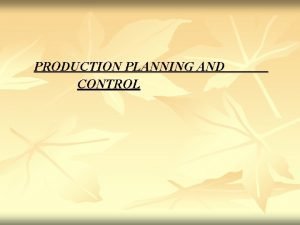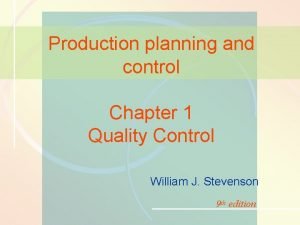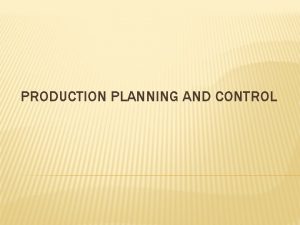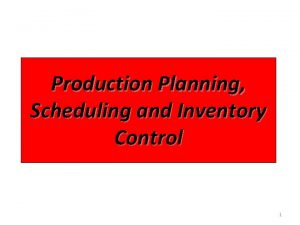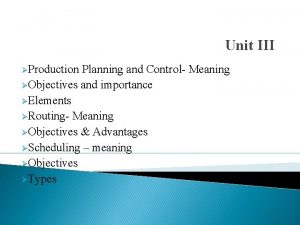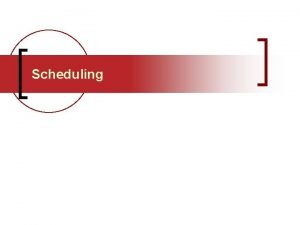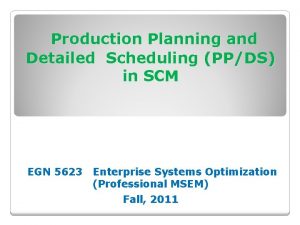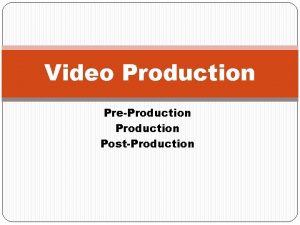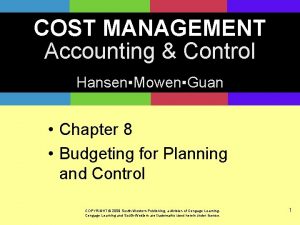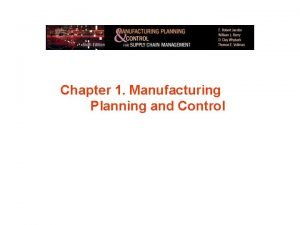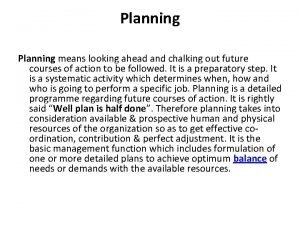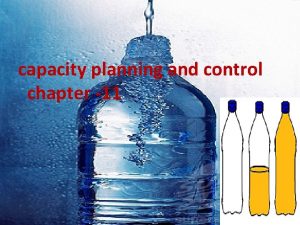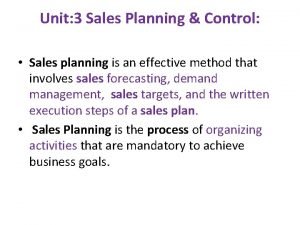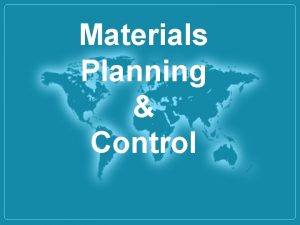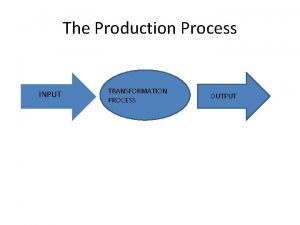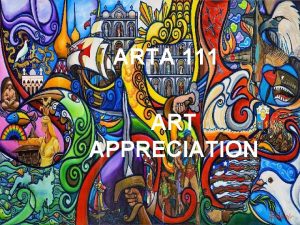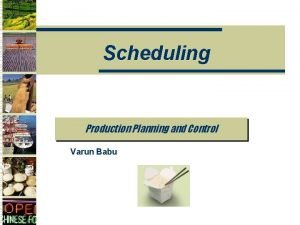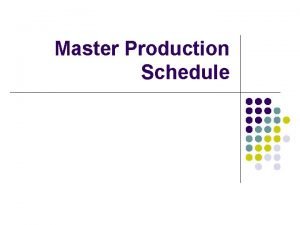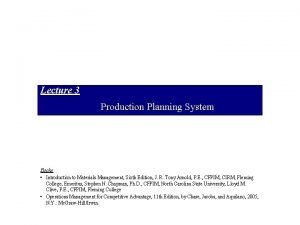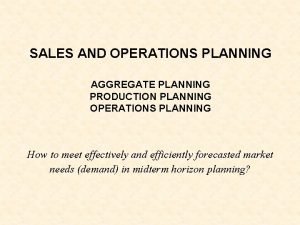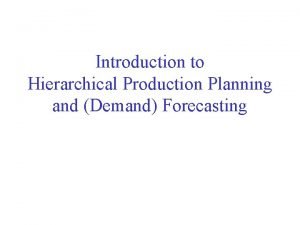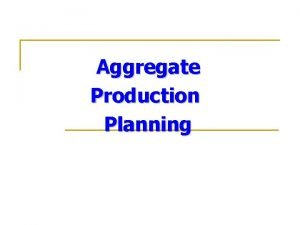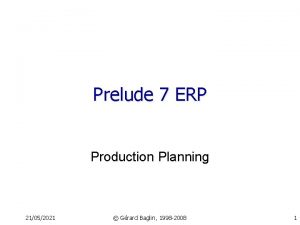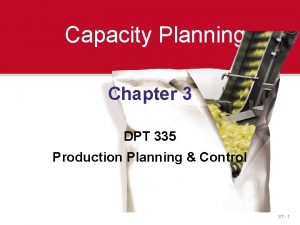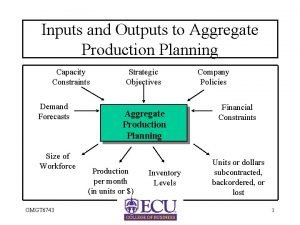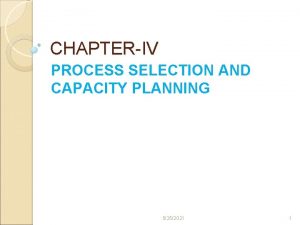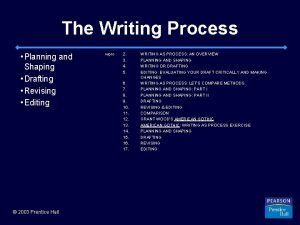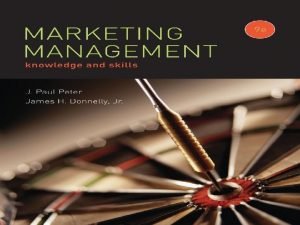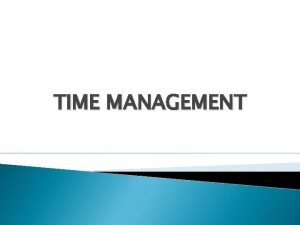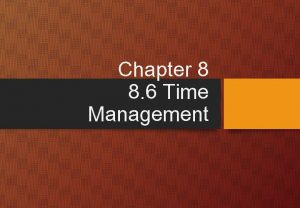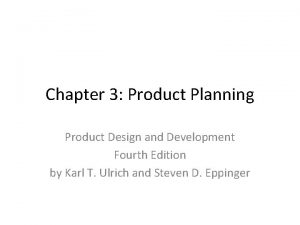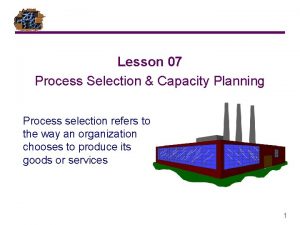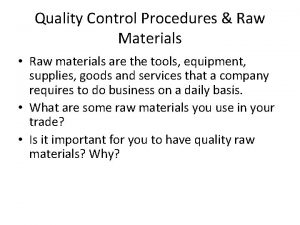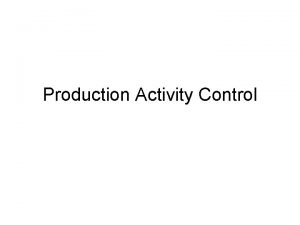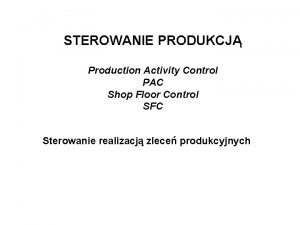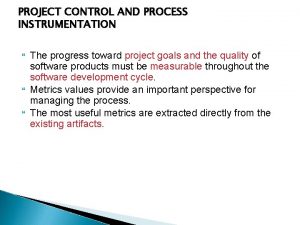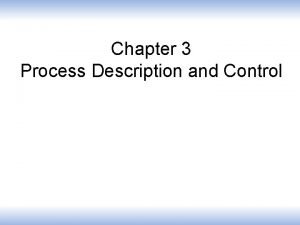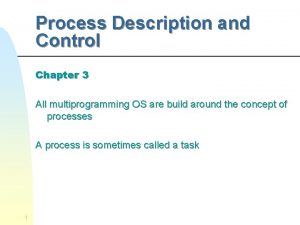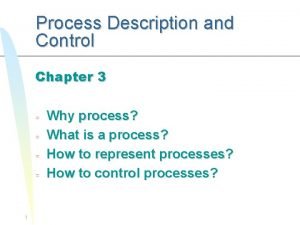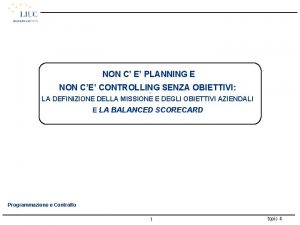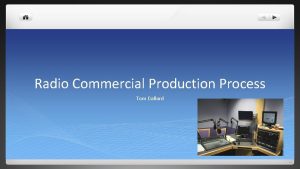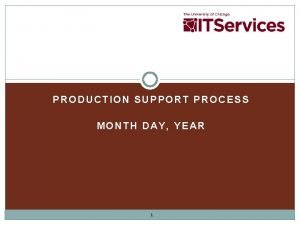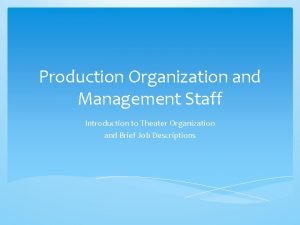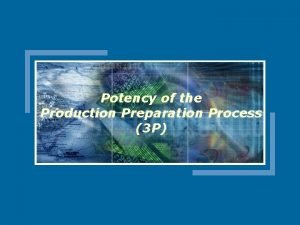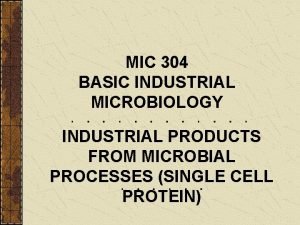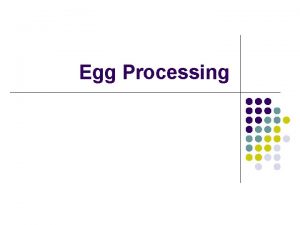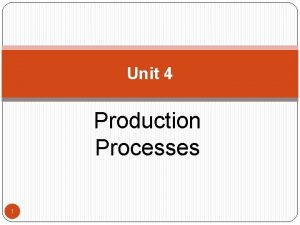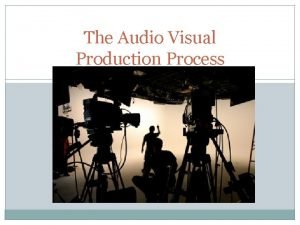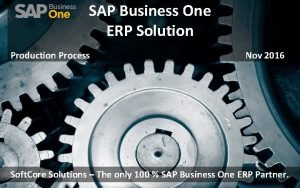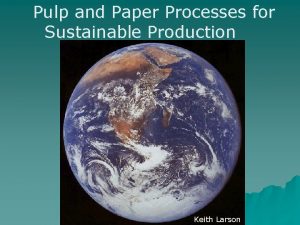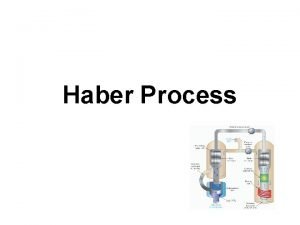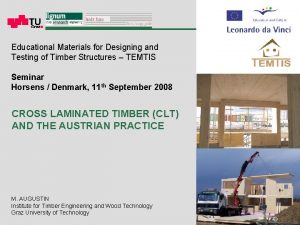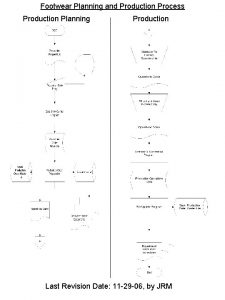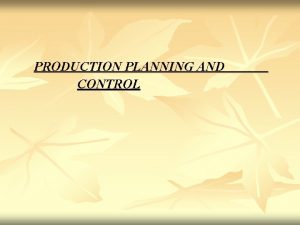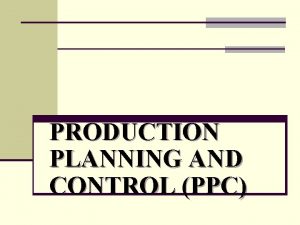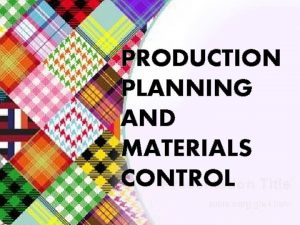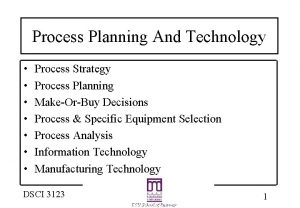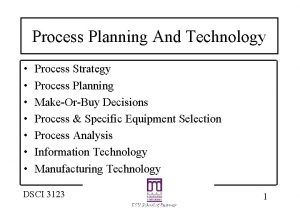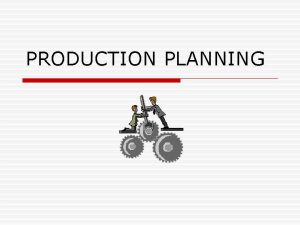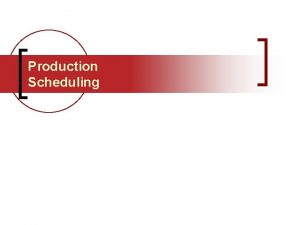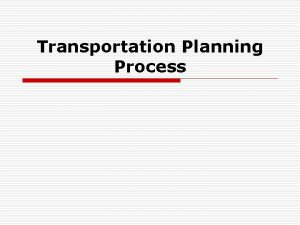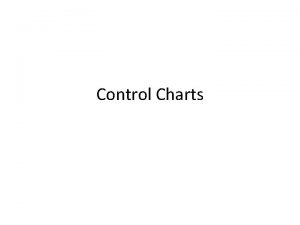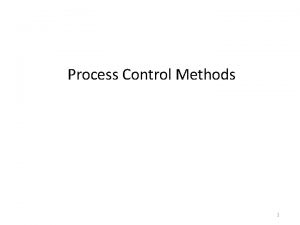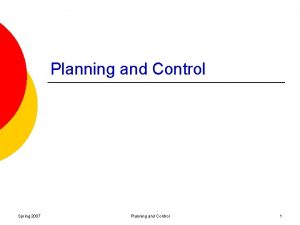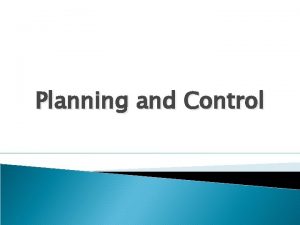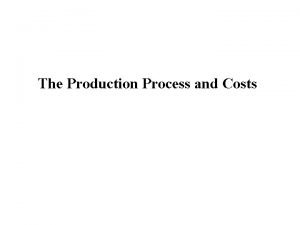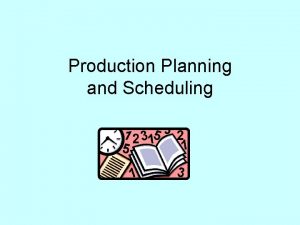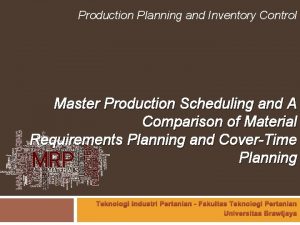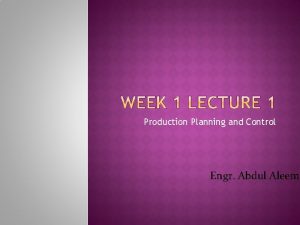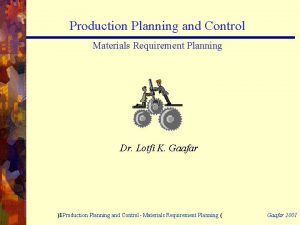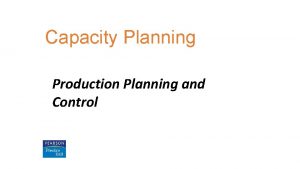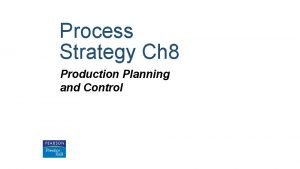Production planning and control Production A process or








































































- Slides: 72

Production planning and control

Production : A process or procedure of converting a set of inputs, namely men, capital, information and energy into finished products or services. Production planning : Production process of looking ahead, anticipating possible difficulties and deciding in advance as to how to produce the products. Production Control : Making sure that production is constantly maintained to produce the products of given specifications.

Requirements for production 1) Money 2) Material 3) Machine 4) Men 5) Method The above are also called as (5 Ms) essential for production.

Organizational chart for P. P. C department

Points while purchasing 1. 2. 3. 4. 5. 6. 7. Right source Right quality Right quantity Right price Right time Right place of delivery Right mode of transportation

Decentralized Purchasing is an activity directed towards securing the materials, supplies, equipment and services required in the operations of an enterprise. Purchase manager is responsible for the effective, efficient and economic operations of the department. Functions of Purchasing Department 1) Ordering section places orders with the vendors. 2) Service section follows the progress of the purchase orders, its shipment by the vendor and its final receipt by the company. 3) Records-section maintains all records of quotations, costs, purchases etc.

• Centralized purchasing : When the company is small, purchasing activities are normally concentrated at one place. If a company has production operations at different places and if the nature of operations is similar, then centralized purchasing is preferred. – Centralized purchasing is invariably an efficient system. – It permits a greater degree of specialization for buying. – Bargaining capabilities are better. – Procuring becomes uniform and consistent materials are procured without price anomalies. – Duplication of efforts is eliminated – Purchasing procedures and payment of invoices become simple.

• Decentralized purchasing : When different branches of a large organization require different types of materials, decentralized purchasing is preferred. When a branch requires large volumes of bulky items, this system of purchasing is adopted. • Advantages : – Purchasing system, purchasing becomes more flexible and efficient. – Procurement is faster – When purchases are made in a local place, it promotes better public relations. – Control over purchases is no longer remote. • Disadvantages : – Quantity of discounts offered is less. It is also involves duplication of efforts. • Advantages of one approach become the disadvantage of the other. A third type partly decentralization and partly centralization is the on which the management should make a policy decision.

Price is defined as the amount of money at which a thing is valued or the value that a seller sets on his goods in the market. Price is the greatest variable in purchasing. Buying Techniques : Quotations : It is an inquiry to know whether the vendor can supply the desired material and if so, by what price 1) 2) Spot quotations Floating a limited enquire Price of the material Place of delivery Taxes Validity of tender Material Specifications Delivery period Terms of payment Guarantee period etc. Tenders : It is written letter or a published document (In newspaper) that is aimed at finding the price for procuring certain materials or for getting a particular job done within the desired period and under specified conditions. Single tender Open tender or Press tender Closed tender or limited tender

Negotiations : It may be defined as an art of arriving at a common understanding through bargaining on the essentials of a contract such as delivery, specifications, prices and terms. Negotiations with the concerned vendors are often necessary before finalizing a purchase contract. The purpose is for fixing and finalizing prices of materials, terms and conditions. Need for negotiations : 1. Prices are related to large volumes or to a large value. 2. Terms and conditions are required for large volumes 3. contract is desired for a longer period 4. Variations in quantity to be purchased are possible. 5. Changes in drawings and specifications are necessary 6. Changes in transportation, packaging and delivery points are to be decided. 7. When supplies or services can be obtained from only one source 8. When no acceptable quotations are received from the responding vendors.

Purchasing cycle and procedure 1) Recognition of need and receipt 2) Selection of potential sources of supply 3) Making request for quotations 4) Receipt and analysis of quotations 5) Selection of right source of supply 6) Issuing the purchase order 7) Follow-up of the order 8) Receipt of materials, reports and analysis 9) Checking and approving of vendor’s invoice for payment 10) Closing of completed orders 11) Maintenance of records and files

Purchasing cycle

Quality is a Lousy Idea- If it’s Only an Idea

Definition of Quality: Quality is the totality of features and characteristics of a product or service that bear on its ability to satisfy stated or implied needs. Some goals of quality programs include: Fitness for use. (Is the product or service capable of being used? ) Fitness for purpose. (Does the product or service meet its intended purpose? ) Customer satisfaction. (Does the product or service meet the customer's expectations? ) Conformance to the requirements. (Does the product or service conform to the requirements? )

Quality Planning The process of identifying which quality standards are relevant to the project and determining how to satisfy them. Input includes: Quality policy, scope statement, product description, standards and regulations, and other process Output. Methods used: benefit / cost analysis, benchmarking, flowcharting, and design of experiments Output includes: Quality Management Plan, operational definitions, checklists, and Input to other processes.

Quality Control The process of monitoring specific project results to determine if they comply with relevant quality standards and identifying ways to eliminate causes of unsatisfactory performance. Input includes: work results, Quality Management Plan, operational definitions, and checklists. Methods used include: inspection, control charts, pareto diagrams, statistical sampling, flowcharting, and trend analysis. Output includes: quality improvements, acceptance decisions, rework, completed checklists, and process adjustments

What is quality control? Quality Control is concerned with the product being developed Quality control system provides routine checks to ensure that the product is being developed correctly without errors. The Quality Control system identifies and addresses product errors/defects. Quality Control ensures that the final product is error free and satisfactory. Quality Control (QC) is often referred to as testing

Quality Control Quality control is a set of “activities” that need to be performed in order to detect problems during production and before the product goes live. These activities ensure that final deliverable meets the specifications and quality standards set by the organization. QC often includes peer reviews, “testing”, code reviews etc.

Quality Control In theory, quality control can be achieved with minimal testing. For example, a thorough review of source code and checks for known previously problems can reduce the possibility of defects and might be enough to meet the quality standards set by the organization. However in most cases, testing is the most important activity for quality control, but it is not the ‘only’ activity.

Quality Control Quality control is extremely important for ensuring that applications are bug free and meet the specifications and requirements, but QC might not always be the most efficient ways of ensuring quality. This is where Quality Assurance plays its role. But it is a concept that is often misunderstood by even the most experienced professions

Productivity may be defined as the ratio of output to input. Output means number of units produced. Inputs are various resources employed. Productivity can be considered as increased, if more goods are produced from the same amount of resources.

Reasons for increasing productivity For Management : To sell more and earn good profits To clear the debts or loans acquired from different sources To establish better position in market For Workers : To get higher wages and standard of living To work in better working conditions To attain job security and satisfaction For Consumers : To Obtain articles at reduced price.

10 steps to improve productivity 1. Management commitment. 2. Training and empowerment 3. Fabric saving 4. Work Study 5. Times and methods 6. Measuring performance 7. Line Balancing 8. Quality 9. Personnel Management 10. Better equipment

Store is a place where excess material is kept which will be used as and when required. Loss of items, deterioration, obsolescence and inadequacy [of what is stored to what is needed] are treated as ‘part of life’.

Store management is “ to receive materials, to protect them while in storage from damage & unauthorized removal, to issue the material in the right quantities, at the right time to the right place and to provide these service promptly and at least cost”.

Objectives of store Minimizing cost of production through minimizing cost on materials Maintaining the value of materials Service to user departments Establishing Co-ordination with other departments Advising materials Manager

Functions of Stores 1. 2. 3. 4. 5. 6. 7. 8. 9. 10. Receipt Storage Retrieval Issue Records Housekeeping Control Surplus management Verification Interaction & coordination

Receipt Any item of goods or material that enters the organization always enters through the stores. Similarly, every item unless specifically excluded, has to leave through the store. Stores is the final account keeper of all materials. Material sent by any supplier after the security clearance comes to the stores. Stores check the document carried by the carrier, known as Delivery Challan, against the copy of the Purchase Order placed on the supplier by the organization.

Receipt Once the adequacy is established and quantity is verified the material is sent for testing for quality parameters. Some times quality control tests are elaborate and time consuming. If the policy of receipt is to unload the material subject to quality control acceptance, it is cleared for unloading. Unloaded material is kept on the hold if it not yet cleared by quality control department. If the material is rejected it is sent back to the supplier after clear

Storage Once the unloaded material is approved by the quality control department, as per the quality plan in the quality system, it is moved to a specific place in the stores layout. The material is so stored that it becomes easy to retrieve and issue subsequently. Storage should also ensure protection against deterioration, damage and pilferage.

Storage Detailed system is adopted for location and labeling of items while in storage. Storage plan is made keeping in mind, 1. nature of the product- physical state, toxicity, inflammability and other hazards 2. volume and weight- heavy or light 3. movement frequency- fast moving or slow moving 4. point of use

Retrieval Easy and quick retrievability of items that are demanded by the internal customers. Easy identification, maximum space utilization and minimum handling are key factors to retrieval functions. It is common knowledge in many of the companies that after hours of searching for the item is declared to be out of stock. This causes hold up of production process and avoidable urgent purchase of out of stock material. This function takes place as per established retrieval

Issue Fulfilling customer demand for the item in minimum time, keeping quality high and cost minimum is issue. An internal customer doesn’t pay the price but he has to fulfill requirement of authorization for the demand. A duly authorized indent or requisition for the item is the key

Records Maintaining records of receipt and issue. Updating the stock levels as per movement of materials. Basic records of store are bin card and stock register. Bin card is placed on the bin in which items are stored. This gives information about receipt, issue and balance. stock register gives all the information in the bin card and also the value.

Housekeeping Maintenance of spic and span cleanliness in the store and ensuring principle of Place for Everything and Everything in its place is fully implemented. Good housekeeping ensures satisfactory work practices

Control Taking measures to ensure material plan is being adhered to. Any changes in consumption pattern or replenishment pattern are closely monitored for corrective action. Material movement is watched to identify nonmoving material for disposal. Effective control puts into effect management objective of ‘no shortage and no excess’.

Surplus management Effective disposal system for unneeded material to reduce inventory cost and proactive measures to eliminate deterioration and obsolescence. Obsolete items are good in all respect but have no useful role in the company due to changes that have occurred in the course of time.

Surplus management Surplus items are those that have accumulated due to faulty planning, forecasting and purchasing. Hence a usage value is associated with these items. Scrap is wastage generated due to processes like turning, boring drilling etc. and also due to bad manufacturing. it is said that in India nearly Rs. 2500 crores are tied up as obsolete, surplus and scrap items.

Verification Stock verification to eliminate gap between information and physical stock. In stores some items are maintained as stock items. The stores triggers the procurement cycle for such items when a predetermined reorder level is reached. Hence correct stock position through verification is critical to ensure ‘no shortage and no excess’ for the item.

Interaction & coordination Very close interaction between Purchasing, production, quality control and engineering functions is obviously needed in the discharge of the functions discussed so far. It also becomes necessary to coordinate the flow of material samples and information through a network of departments for performance of stores functions. Besides, every management function being an internal customer interaction is very important.

Types of Stores Centralized store Decentralized store

Centralized or decentralized stores organization Centralized stores concept is to store all items at a central place and control materials movement from this central place. Whereas Decentralization concept is moving the material to the respective consumer function or directly to the points of use.

Centralized Store Figure Heat Machine treatment shop Store office Molding & casting Fitting shop

Features of centralized stores organization 1. 2. 3. 4. 5. 6. 7. 8. Effective supervision and control. Issue at single point reduces cost of issue Reduced personnel requirement Efficient layout for stores Better handling technology Better inventory checks Maintenance of optimum stores Elaborate documentation

Advantages of centralized store The variety of goods can be supplied to all users from one small location. Less manpower will be required. Better control of materials is possible. Material handling will be easy. Wastage and deterioration of materials will be less.

Disadvantages of centralized store It may not be suitable for large manufacturing concern. More staff will be required for shifting & transportation of the materials to various production units. Record keeping is difficult.

Decentralized Stores Figure Machine shop • Store Molding & Casting • Store Fitting shop • Store

Features of decentralized stores organization 1. 2. 3. 4. Reduced handling Customer friendly Fewer production stoppages Visual management is easier

Advantages of decentralized stores Reduced material handling and associated cost. Less chances of bottlenecks and delays. Convenient for every department to draw materials. Less transportation time.

Disadvantages of decentralized stores Coordination and control of all decentralised store is a challenge to management. Labor utilization may suffer due to low store activity level.

Some other types of storage As per types of the materials stored 1. 2. 3. 4. 5. 6. 7. Raw Materials store Components store Work in process store Finished goods store Semi finished goods store Tools store Consumable materials store

Cont… As per nature of the materials stored 1. 2. 3. 4. LPG store Chemicals store Hazardous materials store Refrigerated materials store

Cont… 1. 2. 3. 4. As per function of the storage receiving store central store general stores sub stores

Stores Layout Physical arrangement of storage facilities for efficient receipt, storage and issue of materials is called as layout of stores. In a properly arranged store, the material are properly maintained. It involves minimum of handling and optimum utilization of space.

Factors affecting stores layout Type of Stock Volume of stock Availability of space Physical factors

Store System Closed door system: the stored material is held under lock and key. Entry into the store is restricted authorized persons only. Physical movement of the material is only with authorized documents only. Maximum security and tight control on movement are features of this system Open stores system: In this system material is stored near point of use and there is restriction on consumption. Control passes on to the operations department

General functions of the stores department Maintenance of stocks in stores Maintenance of hygiene, sanitation and pest control Maintenance of material handling equipment Specific functions of stores department Receiving inspecting and recording of raw materials Arranging for QC of raw materials Positioning and storage Issuing and recording Receiving and dispatching of finished goods Operational functions of stores department Dispensing Screening of materials Physical verification of stores or stock taking Annual physical verification system Perpetual inventory and continuous stock taking system

Functions of Stores management

classifying items into different categories, thereby directing appropriate attention to the material in the contest company’s viability.

A–B-C Classification of inventories : When a large number of items are involved, relatively a few items account for a major part of activity, based on annual value of consumption of items. V-E-D Classification : It stands for Vital, essential and desirable, respectively. Spare parts of equipment, as they do not follow a predictable demand pattern. For v-items, reasonably large stock might be necessary. H-M-L classification : It stands for High, medium and low respectively based on the unit value (in RS) of items. F-S-N Classification : It stands for fast-moving, slow-moving and non-moving respectively in account the distribution and handling(issue) patterns of items from stores.

S-D-E Classification : It stands for scarce, difficult and easy respectively is based on lead-time analysis and availability. S-O-S classification : Some items are seasonal In nature and hence require special purchasing and stocking strategies. EOQ cannot be applied. Inventories at the time of procurement will be extremely high. G-O-L-F classification : It stands for Government, ordinary, local and Foreign respectively. Imported items procuring process for Raw- material. X-Y-Z classification : It is based on the value of inventory stored. If the values are high, special efforts should be made to reduce them.

Reorder quantity methods Quantity of items to be ordered so as to continue production without any interruptions in the future. The Methods employed for reorder quantity are : Fixed quantity system : The reorder quantity is fixed one and therefore, the time for ordering varies. It is calculated using EOQ formula as Reorder level quantity(ROL or reorder point) = Safety stock + (usage rate X lead-time) Determining ROL in a two-bin system : Open access bin system : The bin is filled with items to the maximum level as and when required. Open bins with items are kept at places nearer to the production lines. Two-bin system : Two bins are kept having items at different levels. When the first bin is exhausted, it indicates the time for reorder. The second bin is a reserve stock and used during the lead-time period.

Economic order quantity (EOQ) It is also called as Economic Lot size formula is used to take certain decisions : 1) How much of items to buy (or order) at a time ? 2) When should items be made available for the production ? EOQ equation : It considers two sets of events, namely, procurement costs and carrying costs. EOQ model provides a level of inventory at which the combined costs of procurement and carrying inventory are minimum.

EOQ Formula can be written as Where Q = economic lot size or EOQ S = Ordering cost associated with one order, RS A = Annual usage units I = Annual inventory carrying costs expressed as decimal per unit. U = Cost of one unit, Rs

Inventory categories – Special considerations 1) Production inventories : Materials used or chemicals such as active ingredients needed to manufacture the finished products. 2) MRO inventories(Maintenance, repairs and operating supplies) : Parts or subassemblies are needed for the final assembly of the end product. 3) Work-in-progress(WIP) inventories : Work in process materials and components are the items on which work is to be done further. 4) Finished goods inventories : Finished goods as saleable items, dosage forms, bulk drugs, physician’s samples or promotional items held in inventory awaiting customer’s orders or made for specific customers.

Production scheduling Definition : A process of decision taking to start the work for production. Importance : Production scheduling optimizes the production and inventory costs by properly sequencing the orders and time phasing. Production schedule is the basic means for : Monitoring production activities Checking the progress of production Decision making during the production cycle.

Forecasting Definition forecasting is estimating future demand for products and services and the resources necessary to produce these outputs. Needs for Sales Forecasting 1) New facility planning 2) Production planning 3) Work force scheduling 4) Financial planning

classifying items into different categories, thereby directing appropriate attention to the material in the contest company’s viability.

A–B-C Classification of inventories : When a large number of items are involved, relatively a few items account for a major part of activity, based on annual value of consumption of items. V-E-D Classification : It stands for Vital, essential and desirable, respectively. Spare parts of equipment, as they do not follow a predictable demand pattern. For v-items, reasonably large stock might be necessary. H-M-L classification : It stands for High, medium and low respectively based on the unit value (in RS) of items. F-S-N Classification : It stands for fast-moving, slow-moving and non-moving respectively in account the distribution and handling(issue) patterns of items from stores.

S-D-E Classification : It stands for scarce, difficult and easy respectively is based on lead-time analysis and availability. S-O-S classification : Some items are seasonal In nature and hence require special purchasing and stocking strategies. EOQ cannot be applied. Inventories at the time of procurement will be extremely high. G-O-L-F classification : It stands for Government, ordinary, local and Foreign respectively. Imported items procuring process for Raw- material. X-Y-Z classification : It is based on the value of inventory stored. If the values are high, special efforts should be made to reduce them.

Reorder quantity methods Quantity of items to be ordered so as to continue production without any interruptions in the future. The Methods employed for reorder quantity are : Fixed quantity system : The reorder quantity is fixed one and therefore, the time for ordering varies. It is calculated using EOQ formula as Reorder level quantity(ROL or reorder point) = Safety stock + (usage rate X lead-time) Determining ROL in a two-bin system : Open access bin system : The bin is filled with items to the maximum level as and when required. Open bins with items are kept at places nearer to the production lines. Two-bin system : Two bins are kept having items at different levels. When the first bin is exhausted, it indicates the time for reorder. The second bin is a reserve stock and used during the lead-time period.

Production Organization
 Meaning of production planning and control
Meaning of production planning and control Quality control chart
Quality control chart Route card in manufacturing
Route card in manufacturing Inventory management and production planning and scheduling
Inventory management and production planning and scheduling Bagan alur proses produksi multimedia
Bagan alur proses produksi multimedia Production meaning
Production meaning Difference between process control and product control
Difference between process control and product control Localü
Localü Production planning and detailed scheduling
Production planning and detailed scheduling Pre production planning for video film and multimedia
Pre production planning for video film and multimedia Proactive planning and reactive planning
Proactive planning and reactive planning Short, medium and long term planning in education
Short, medium and long term planning in education What is language planning
What is language planning Aircraft maintenance planning
Aircraft maintenance planning Budget planning and control
Budget planning and control Mpc classification
Mpc classification Planning is looking ahead
Planning is looking ahead Chase capacity plan
Chase capacity plan Types of sales planning
Types of sales planning Materials planning and control
Materials planning and control Input and output in production process
Input and output in production process Artist or artisan medium and technique
Artist or artisan medium and technique Negative regulation
Negative regulation Control flow error
Control flow error Production planning report
Production planning report What is master production schedule
What is master production schedule Chase strategy disadvantages
Chase strategy disadvantages Aggregate planning models
Aggregate planning models Hierarchical production planning
Hierarchical production planning Aggregate production planning example
Aggregate production planning example Prelude 7 erp
Prelude 7 erp Bakery production planning
Bakery production planning What is master production schedule
What is master production schedule Process selection and capacity planning
Process selection and capacity planning Planning drafting revising editing
Planning drafting revising editing Crm project design and planning process
Crm project design and planning process Product planning and development definition
Product planning and development definition Time management is the process of organizing and planning
Time management is the process of organizing and planning 8+8+8 time management
8+8+8 time management Product platform
Product platform Planning programming budgeting and execution ppbe process
Planning programming budgeting and execution ppbe process Process selection and capacity planning
Process selection and capacity planning Strategic planning vs tactical planning
Strategic planning vs tactical planning Planning balance sheet in urban planning
Planning balance sheet in urban planning Role segmentation workforce planning
Role segmentation workforce planning Perencanaan kapasitas dan agregat
Perencanaan kapasitas dan agregat Aggregate planning is capacity planning for
Aggregate planning is capacity planning for Examples of aggregate planning
Examples of aggregate planning Receiving raw material
Receiving raw material Production activity control
Production activity control Algorytm johnsona dla 3 maszyn
Algorytm johnsona dla 3 maszyn Production activity control
Production activity control Project control and process instrumentation
Project control and process instrumentation Process design and control design should always be in
Process design and control design should always be in Process description and control in operating system
Process description and control in operating system Process description and control
Process description and control Process description and control
Process description and control Controlling v praxi
Controlling v praxi Radio commercial production process
Radio commercial production process It production support process
It production support process Production process in theatre
Production process in theatre Production preparation process definition
Production preparation process definition Symba process
Symba process Cheese making process diagram
Cheese making process diagram Egg processing line
Egg processing line Vertical
Vertical What is visual production
What is visual production Names of sugar alcohols
Names of sugar alcohols Production process in sap b1
Production process in sap b1 Process of making paper
Process of making paper System design in operations management
System design in operations management Chemistry haber process diagram
Chemistry haber process diagram Clt production process
Clt production process
